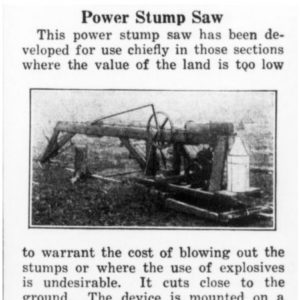calsfoundation@cals.org
Stump Saw
Consisting of vernacular technology that combined a horizontally positioned circular saw blade with an automobile engine, the stump saw was used to clear rice fields of virgin timber during the early twentieth century.
In northeast Arkansas perhaps as early as 1909, the stump saw became essential to rice cultivation after farmers had planted all the region’s treeless prairie and had turned to post oak flats and sloughs for potential rice acreage. In order to cut off trees at or below ground level, farmers developed a device consisting of a circular saw blade, probably a cast-off from a sawmill, fixed horizontally on a sled and driven by a gasoline engine. The rear axle and differential of a Model A Ford (or sometimes a Model T) would be rotated so that the axle was vertical. The saw blade was attached to the axle, and a team of draft animals dragged the contraption into the fields where the sawyer could position the blade using bicycle-like handlebars. The teeth of the saw blade had been treated with Stalite, a metallic alloy, to harden a cutting edge that often had to penetrate mud and rocks as well as the stump itself.
Despite some decline in the rice boom, which had flourished until World War I, the stump saw continued in use through the 1930s and occasionally into the 1940s, when improved technology provided it with more power. Although the invention of a tree saw that could take down an entire tree at below ground level and the emergence of the bulldozer made the stump saw obsolete, a generation of rice farmers had relied on the stump saw, contracting with local timbermen to clear fields for them so that they could establish Arkansas as one of the country’s principal rice producers early in the twentieth century.
For additional information:
Clements, William M., and Larry D. Ball. “‘This Was the Beginning of Clearing of Land’: The Development and Use of the East Arkansas Stump Saw.” Arkansas Historical Quarterly 45 (Spring 1986): 41–52.
Harrison, Robert W. “Clearing Land in the Mississippi Alluvial Valley.” Arkansas Historical Quarterly 13 (Winter 1954): 352–371.
Jenks, George F., and Robert W. Harrison. Methods and Cost of Clearing Land in Northeast Arkansas. University of Arkansas Agricultural Experiment Station Bulletin 495. Fayetteville: University of Arkansas Agricultural Experiment Station, 1950.
William M. Clements
Arkansas State University
 Early Twentieth Century, 1901 through 1940
Early Twentieth Century, 1901 through 1940 Folklore and Folklife
Folklore and Folklife Stump Saw Ad
Stump Saw Ad 




Comments
No comments on this entry yet.